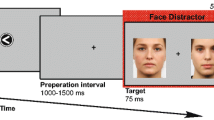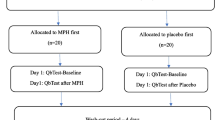Abstract
The effect of methylphenidate preceded by a moderate dose of haloperidol on reaction times over the duration of a continuous performance test (CPT) was investigated in ten male children, with a DSM-III diagnosis of attention deficit disorder with hyperactivity disorder (ADDH). Using a within-subject double-blind design, the effects of methylphenidate preceded by haloperidol on reaction time during the first and second blocks of CPT test were compared. Methylphenidate maintained a significantly improved reaction time in the second block of the CPT test. When methylphenidate, preceded by placebo, was preceded by haloperidol this effect was not observed, suggesting opposing effects on attentional systems by methylphenidate versus haloperidol. The study is the first to examine the “blocking” effect of haloperidol over the course of a CPT. The results suggest that dopamine systems are involved in the maintenance of the CPT response, and support an “incentive motivation” theory of sustained attention.
Similar content being viewed by others
References
Barkley RA (1990) Attention deficit hyperactivity disorder. A handbook for diagnosis and treatment. Guilford Press, New York
Barrett RJ, White DK (1980) Reward system depression following chronic amphetamine: antagonism by haloperidol. Pharmacol Biochem Behav 13:555–559
Congalton A (1969) Status and prestige in Australia. Cheshire, Melbourne
de Sonneville LMJ, Njiokiktjien C, Hilhorst RC (1991) J Child Psychol Psychiatry 32 [2]:285–295
Douglas VI (1993) Attention and cognitive problems. In: Rutter M (ed) Developmental neuropsychiatry. Guilford Press, New York
Klorman R (1991) Cognitive event-related potentials in attention deficit disorder. J Learn Disabil 24 [3]:130–140
Klorman R, Salzman LF, Pass HL, Borgstedt AD, Dainer KG (1979) Effects of methylphenidate on hyperactive children's evoked responses during passive and active attention. Psychophysiology 16 [1]:23–29
Levy F (1980) The development of sustained attention (vigilance) and inhibition in children: some normative data. J Child Psychol Psychiatry 21:77–84
Levy F (1991) The dopamine theory of attention deficit hyperactivity disorder (ADHD). Aust NZ J Psychiatry 25:277–283
Levy F, Hobbes G (1988) The action of stimulant medication in attention deficit disorder with hyperactivity: dopaminergic, noradrenergic, or both? J Am Acad Child Adoles Psychiatry 276:802–805
Levy F, Hobbes G (1981) The diagnosis of attention deficit disorder (hyperkinesis) in children. J Am Acad Child Adoles Psychiatry 20:376–384
Michel RL, Klorman R, Salzman LF, Borgstedt AD, Dainer KB (1981) Normalizing effects of methylphenidate on hyperactive children's vigilance performance and evoked potentials. Psychophysiology 18:665–677
Mogenson GJ, Jones DL, Yim CY (1980) From motivation to action: functional interface between the limbic system and the motor system. Prog Neurobiol 14:69–97
Robbins TW, Sahakian BJ (1979) “Paradoxical” effects of psychomotor stimulant drugs in hyperactive children from the standpoint of behavioural pharmacology. Neuropharmacology 18:931–950
Robbins TW, Sahakian BJ (1983) Behavioural effects of psychomotor stimulant drugs clinical and neuropsychological implications. In: Creese I (ed) Stimulants: clinical behavioural and neurochyemical perspectives. Raven Press, New York, pp 301–338
Sroufe LA (1975) Drug treatment of children with behaviour problems. In: Horowitz F (ed) Review of child development research vol. 4. University of Chicago Press, Chicago
Straus J, Lewis JL, Klorman R, Peloquin LJ, Perlmutter RA, Salzman LF (1984) Effects of methylphenidate on young adults' performance and event-related potentials in a vigilance and paired-associates learning test. Psychophysiology 21:609–621
Sykes DH, Douglas VI, Weiss G, Minde K (1971) Attention in hyperactive children and the effect of methylphenidate (Ritalin). J Child Psychol Psychiatry 12:129–139
Toates F (1984) Motivational systems. Cambridge University Press, Cambridge and New York
Van der Meere J, Sergeant J (1988) Controlled processing and vigilance in hyperactivity: time will tell. J Abnorm Child Psychol 16 [6]:641–655
Werry J, Amon MG (1975) Methylphenidate and haloperidol in children. Arch Gen Psychiatry 32:790–795
Willner P (1985) Depression: a psychological synthesis. Wiley, New York
Zametkin AJ, Rapoport JL (1987) Neurobiology of attention deficit disorder with hyperactivity: where have we come in 50 years? J Am Acad Child Adoles Psychiatry 26:670–686
Author information
Authors and Affiliations
Rights and permissions
About this article
Cite this article
Levy, F., Hobbes, G. Does haloperidol block methylphenidate?. Psychopharmacology 126, 70–74 (1996). https://doi.org/10.1007/BF02246413
Received:
Revised:
Issue Date:
DOI: https://doi.org/10.1007/BF02246413




